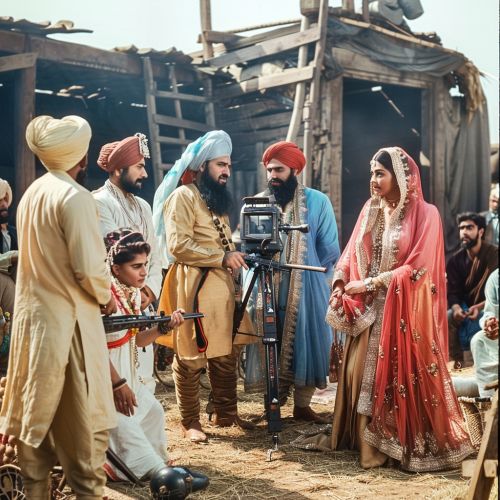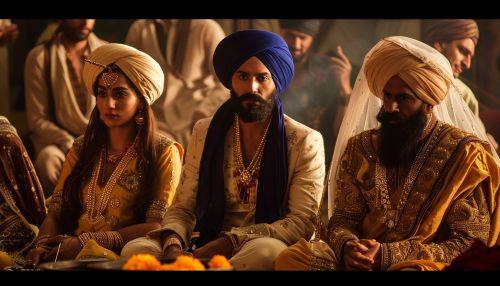Punjabi cinema
History of Punjabi Cinema
Punjabi cinema, also known as Pollywood, refers to the film industry in the Punjabi language in the Indian state of Punjab and the Punjabi diaspora. The origins of Punjabi cinema can be traced back to the early 20th century. The first Punjabi film, "Sheela," also known as "Pind Di Kudi," was released in 1935. Directed by K.D. Mehra, it marked the beginning of a new era in regional Indian cinema.


Early Years (1930s-1960s)
The initial years of Punjabi cinema were marked by sporadic productions, primarily due to the lack of infrastructure and financial constraints. Despite these challenges, several notable films were produced during this period. "Heer Ranjha" (1932), directed by Abdul Rashid Kardar, was one of the early successes. The film was based on the famous Punjabi folklore of Heer and Ranjha, which remains a popular theme in Punjabi cinema.
The partition of India in 1947 had a significant impact on Punjabi cinema. Many filmmakers and artists migrated to India from the newly formed Pakistan, leading to a temporary decline in film production. However, the industry gradually recovered, and the 1950s and 1960s saw the release of several successful films such as "Bhangra" (1959) and "Satluj De Kande" (1964).
Golden Era (1970s-1980s)
The 1970s and 1980s are often referred to as the golden era of Punjabi cinema. This period witnessed the emergence of iconic actors like Dharmendra, Raj Babbar, and Gurdas Maan. Films such as "Nanak Naam Jahaz Hai" (1969), "Mera Pind" (1971), and "Chann Pardesi" (1980) achieved both critical and commercial success.
"Nanak Naam Jahaz Hai" is particularly noteworthy for its portrayal of Sikh religious themes and its impact on the Punjabi community. Directed by Ram Maheshwari, the film was a milestone in Punjabi cinema and set new standards for storytelling and production quality.
Decline and Revival (1990s-2000s)
The 1990s saw a decline in the production of Punjabi films, largely due to the rise of Bollywood and the increasing popularity of Hindi cinema. However, the early 2000s marked the beginning of a revival phase. Films like "Jee Aayan Nu" (2002) and "Asa Nu Maan Watna Da" (2004) played a crucial role in revitalizing the industry.
This period also saw the advent of modern filmmaking techniques and the incorporation of contemporary themes. The success of these films encouraged new filmmakers to explore diverse genres, leading to a resurgence in the popularity of Punjabi cinema.
Contemporary Era (2010s-Present)
The contemporary era of Punjabi cinema is characterized by a blend of traditional and modern elements. Films such as "Jatt & Juliet" (2012), "Punjab 1984" (2014), and "Sardar Udham" (2021) have garnered both national and international acclaim. These films have not only entertained audiences but also addressed important social and historical issues.
The rise of digital platforms has further expanded the reach of Punjabi cinema, allowing filmmakers to connect with a global audience. The industry continues to evolve, with a focus on high-quality production, innovative storytelling, and the exploration of new genres.
Genres and Themes
Punjabi cinema encompasses a wide range of genres and themes, reflecting the rich cultural heritage of the region. Some of the most prominent genres include:
Romantic Dramas
Romantic dramas have been a staple of Punjabi cinema since its inception. Films like "Heer Ranjha" and "Mirza Sahiban" are based on classic Punjabi love stories. Contemporary romantic dramas such as "Jatt & Juliet" and "Qismat" have also achieved significant success.
Comedy
Comedy is another popular genre in Punjabi cinema. Films like "Carry On Jatta" (2012) and "Bhaji in Problem" (2013) have been well-received for their humorous take on everyday situations. The use of witty dialogues and situational comedy has made these films a favorite among audiences.
Social and Political Dramas
Punjabi cinema has a long tradition of addressing social and political issues. Films like "Punjab 1984" and "Sardar Udham" explore historical events and their impact on society. These films often serve as a medium for raising awareness and promoting social change.
Action
Action films have gained popularity in recent years, with movies like "Singham" (2019) and "Shadaa" (2019) featuring high-octane sequences and thrilling storylines. The incorporation of modern action choreography and special effects has elevated the genre to new heights.
Musical Films
Music plays a vital role in Punjabi culture, and this is reflected in the cinema. Musical films like "Dil Vil Pyaar Vyaar" (2014) and "Angrej" (2015) showcase the rich musical traditions of Punjab. These films often feature elaborate song and dance sequences, adding to their appeal.
Notable Personalities
Punjabi cinema has been shaped by the contributions of numerous talented individuals, including actors, directors, and musicians.
Actors
- **Dharmendra**: Known for his work in both Punjabi and Hindi cinema, Dharmendra is one of the most iconic actors in Indian film history. His performances in films like "Kankan De Ohle" (1970) have left a lasting impact.
- **Gurdas Maan**: A legendary singer and actor, Gurdas Maan is celebrated for his roles in films like "Shaheed-E-Mohabbat Boota Singh" (1999). His contribution to Punjabi music and cinema is unparalleled.
- **Neeru Bajwa**: One of the leading actresses in contemporary Punjabi cinema, Neeru Bajwa has starred in numerous successful films, including "Jatt & Juliet" and "Channo Kamli Yaar Di" (2016).
Directors
- **Manmohan Singh**: A prolific director and cinematographer, Manmohan Singh has directed several acclaimed Punjabi films, including "Jee Aayan Nu" and "Dil Apna Punjabi" (2006).
- **Anurag Singh**: Known for his work in both Punjabi and Hindi cinema, Anurag Singh has directed hits like "Punjab 1984" and "Kesari" (2019).
Musicians
- **Surinder Kaur**: Often referred to as the "Nightingale of Punjab," Surinder Kaur's contributions to Punjabi music have been immense. Her songs have been featured in numerous Punjabi films.
- **Hans Raj Hans**: A renowned singer, Hans Raj Hans has lent his voice to many Punjabi film soundtracks. His soulful renditions have made him a beloved figure in the industry.
Influence and Impact
Punjabi cinema has had a significant influence on the cultural landscape of Punjab and the broader Indian subcontinent. It has played a crucial role in preserving and promoting Punjabi language, music, and traditions. The portrayal of Punjabi folklore, festivals, and rituals in films has helped in keeping these cultural elements alive.
The success of Punjabi films has also had an economic impact, contributing to the growth of the regional film industry. The popularity of Punjabi cinema has led to increased investment in film production, infrastructure, and talent development.
Furthermore, Punjabi cinema has made a mark on the global stage, with films being screened at international film festivals and receiving accolades. The diaspora community has played a vital role in this regard, supporting and promoting Punjabi films worldwide.
Challenges and Future Prospects
Despite its successes, Punjabi cinema faces several challenges. The industry often struggles with issues related to funding, distribution, and piracy. The dominance of Bollywood also poses a challenge, as Punjabi films compete for screen space and audience attention.
However, the future prospects for Punjabi cinema are promising. The rise of digital platforms and the increasing demand for regional content provide new opportunities for filmmakers. The industry's focus on high-quality production and innovative storytelling is likely to attract a broader audience.
Efforts are also being made to address the challenges related to funding and distribution. Government initiatives and private investments are being directed towards the development of film infrastructure and talent. The establishment of film schools and training programs is expected to nurture the next generation of filmmakers and artists.
